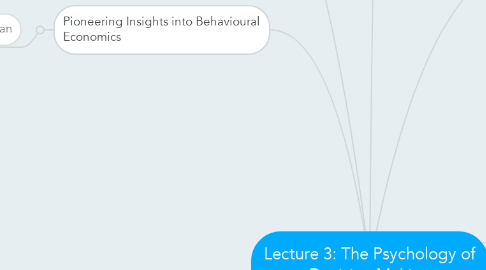
1. Pioneering Insights into Behavioural Economics
1.1. Daniel Kahneman
1.1.1. Psychologist
1.1.2. Won the Nobel Prize in 2002
1.1.3. Thinking Fast and Slow
1.1.3.1. Baed on 35 years of research
1.1.3.2. Experiments on different people in different contexts
1.1.3.3. Tversky and Kahneman were interested in why people fell into errors and traps
1.1.3.3.1. They believed it more interesting to look into what people do wrong rather than what they do correctly
2. Heuristics and Biases
2.1. Satisficing (Simon, 1955)
2.1.1. Satisfice, make the best decision possible given information available
2.2. Representativeness (Kahneman, 1974)
2.3. Availability and Anchoring (Kahneman, 1974)
2.3.1. Took lots of experiments
2.4. Affect (Finucane, 2000)
2.4.1. How emotions affect decision making
2.4.2. How can emotion and testosterone get in the way of decision making in System 1
2.4.2.1. You need both men and women to counteract each other in decision making
2.4.2.2. If you have women on boards, decisions are more reflective and usually more successful
2.5. Confirmation (Bazerman, 2005)
2.5.1. Seek to confirm decision making in order to make them feel more comfortable
2.5.1.1. People rarely question behaviour
2.5.1.1.1. This makes management overconfident
2.5.1.1.2. E.g. Barack Obama didn't want to be surrounded by YES people
2.6. Overconfidence
3. What makes a good decision
3.1. Is a good decision one which has a good final outcome or one that follows reasonable steps and stages
3.1.1. PROSPECT THEORY (Kahneman, 1979)
3.1.1.1. Alternative model to expected utility theory
3.1.1.2. Value assigned to gains and losses rather that outcomes
3.1.1.3. Probabilities are replaced by decision weights
3.1.1.4. Graph is concave for gains
3.1.1.4.1. Implying risk aversion
3.1.1.5. Graph is convex for losses
3.1.1.5.1. Implying risk seeking
3.1.1.6. Losses therefore outweigh gains in value
3.1.1.7. Whatever the frame, if you frame in terms of losses this will always have a larger effect
3.1.1.7.1. Losses loom larger than gains
3.1.2. Framing
3.1.2.1. Where does framing influence behaviour in our own lives
3.1.2.2. Important in selection process in salary negotiation
3.1.2.3. Schwartz - the tyranny of choice
3.1.2.3.1. Widely believed that more choice allows us to get what we want
3.1.2.3.2. However, in some cases there can be too much choice leading to...
4. Humans are behavioural decision makers
4.1. Edwards (1954) Human choice and maximising subjective expected utility does not fit the facts
4.1.1. We are not rational decision makers
4.2. Research has identified a number of rules of thumb or heuristics that enable people to cut through detailed information (Kahneman, 1982)
4.2.1. These heuristics are shortcuts in thinking that people make
4.2.1.1. Availability
4.2.1.1.1. How do we access information
4.2.1.2. Representativeness
4.2.1.2.1. How representative of an idea our brand is
4.2.1.3. Anchoring
4.2.1.3.1. Behaving in ways that other individuals wants us to behave that we would normally not
4.2.1.4. Adjustment
4.2.2. Novice thinkers are bombarded with masses of information and have to navigate through it
4.2.3. Use of heuristics reduces the information processing requirements
4.2.3.1. But may also yield poor judgement and choices
5. Making a decision? Take your time
5.1. Brain imaging studies show that low offers activate the anterior insula, an area associated with feelings of disgust or anger
5.2. A delay allows the participant to chill out and accept the most logical and best answer
5.2.1. Even if the offer is very low
5.3. Have a tendency to want to protect our egos so low offers are rejected immediately
6. System 1 and 2 Thinking
6.1. Interpretations of how we think
6.1.1. Kahneman's work
6.1.1.1. Thinking fast is System 1
6.1.1.2. Thinking slow is System 2
6.2. We have two patterns of thought
6.2.1. System 1: Intuitive
6.2.2. System 2: Reverse - slow decision making
6.3. They compete with each other
6.3.1. We use our fast thinking system more than we should
6.4. However, some neuro-psychologists suggest that we have many different types of thinking processes and systems
7. Illustration of two tables
7.1. Table tops are the same size
7.2. Framing makes participants use System 1
7.3. When we look at problems we use System 1 too quickly
7.3.1. This makes us fall into systematic errors and biases
7.4. Need to think more in terms of System 2
8. Simple Heuristics That Make Us Smart
8.1. By Gerd Gigerenzer who created the Fast and Frugal Heuristics
8.1.1. Identified a bias called Loss Aversion

